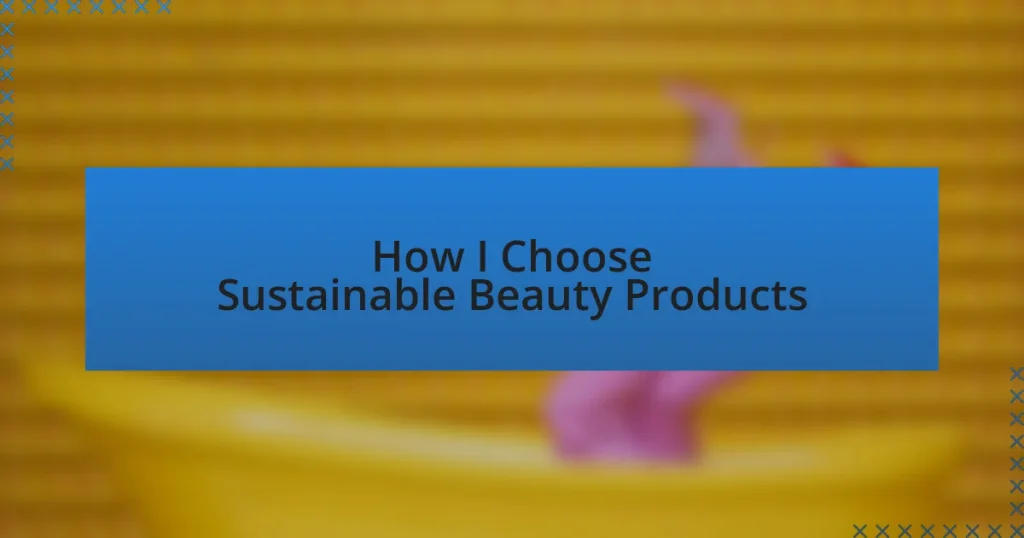Key takeaways:
- Sustainable beauty products are made with natural ingredients and prioritize ethical sourcing, contributing to environmental health and personal well-being.
- Key factors in sustainability include ingredient sourcing, eco-friendly packaging, and cruelty-free practices, which reflect brands’ commitment to transparency and accountability.
- Researching brands and their practices enhances consumer trust, making it essential to look for certifications and engage directly with companies.
- Supporting local artisans and using refillable containers not only reduces waste but also fosters a sense of community and connection to the products we use.
Author: Charlotte Hawthorne
Bio: Charlotte Hawthorne is an acclaimed author known for her compelling storytelling and richly drawn characters. With a passion for exploring the complexities of human relationships, her novels often blend elements of romance, intrigue, and self-discovery. A graduate of the University of California, Charlotte has received multiple awards for her work, including the prestigious Silver Quill Award. When she’s not writing, she enjoys hiking in the Sierra Nevada mountains and sipping coffee at local cafes. Charlotte currently resides in San Francisco with her rescue dog, Jasper.
Understanding sustainable beauty products
Sustainable beauty products embody a deep commitment to the environment, often made with natural, organic ingredients that minimize harm to our planet. I remember the first time I swapped a conventional product for a sustainably sourced one; it felt like I was making a small, yet meaningful difference in my daily routine. Isn’t it empowering to know that every choice we make can contribute to a healthier planet?
These products also prioritize ethical sourcing and production practices, which means the brands are transparent about where their ingredients come from. I once discovered a brand that not only used biodegradable packaging but also ensured fair wages for its workers. It made me question how often I had overlooked the story behind a product in favor of its marketing. How many of us are aware of the true cost of “beauty”?
Understanding sustainable beauty goes beyond just the ingredients; it’s about embracing a holistic approach to health, beauty, and ethics. I’ve felt a profound shift in my confidence since choosing products aligned with my values. How liberating is it to radiate both inner and outer beauty with a clear conscience?
Importance of choosing sustainable beauty
Choosing sustainable beauty products is crucial not just for the environment but also for our well-being. I still remember the first time I noticed the difference after switching to eco-friendly skincare; my skin felt healthier, and my mind was at ease knowing I wasn’t contributing to pollution or harmful practices. It’s fascinating how our beauty choices can reflect our values and impact our planet.
Moreover, the importance lies in supporting brands that hold themselves accountable for their environmental footprint. I once visited a local beauty shop that showcased products made with community-sourced ingredients, benefiting both the environment and local economies. Isn’t it incredible to think that with each purchase, we can support ethical labor practices and promote sustainability?
Ultimately, selecting sustainable beauty products can profoundly influence not only our own lives but also the planet’s future. It’s a simple act that resonates with deeper implications for our communities and ecosystems. Have you ever pondered how your everyday choices could set a precedent for a more responsible beauty industry?
Key factors in sustainability
When I think about key factors in sustainability, the first thing that comes to mind is the sourcing of ingredients. It’s not just about what goes into the bottle; it’s about how those ingredients are obtained. For example, when I discovered a brand using fair trade oils, I felt a sense of satisfaction knowing that the workers were treated fairly and the environment wasn’t compromised. Don’t you find it refreshing when a brand is transparent about its supply chain?
Another important aspect is packaging. I’ve always been fascinated by brands that come up with innovative, eco-friendly packaging solutions. Recently, I stumbled upon a skincare line that uses biodegradable containers—an impressive step toward reducing plastic waste. It made me wonder how many products still use excessive packaging that ultimately harms the planet. Have you ever stopped to consider how much plastic you discard each month?
Lastly, I can’t overlook the role of cruelty-free practices in sustainable beauty. I still vividly remember the moment I learned about the testing methods some brands used on animals; it truly broke my heart. Choosing products that are cruelty-free not only align with my values but also inspire others to rethink their beauty routines. Isn’t it empowering to know that our choices can promote compassion in the industry?
Researching beauty brand practices
When I set out to understand a beauty brand’s sustainability practices, I dive deep into their ethical commitments. For instance, I recently researched a brand that proudly publishes its entire supply chain online. It gave me a sense of trust, knowing that every ingredient had a story backed by ethical sourcing. Have you ever felt a connection to a product because of the transparency behind it?
Additionally, I look closely at a brand’s certifications. One time, I discovered a skincare line that held certifications for both organic and cruelty-free standards. It not only made me feel confident in my purchase but also sparked a curiosity about how many other brands claim to be sustainable without the necessary verification. Don’t you find it disappointing when brands don’t back their claims with proven standards?
In my exploration, reaching out to brands directly has also been enlightening. A few months ago, I sent an inquiry to a company known for its eco-friendly approach, asking about their ingredient sourcing. The prompt and thorough response I received reassured me of their commitment to sustainability. It made me reflect on the importance of holding brands accountable and engaging in conversations that inspire positive change. What kind of questions would you want to ask your favorite beauty brand?
Personal criteria for product selection
When choosing sustainable beauty products, the ingredient list is my first stop. I remember picking up a moisturizer that boasted natural ingredients but also had a few synthetic ones that left me uneasy. It sparked a realization: if I’m striving for cleaner options, I need to be vigilant about what I’m putting on my skin. Have you ever checked a label and felt relieved or disappointed?
Another aspect I consider is the brand’s packaging. Recently, I came across a shampoo bar that eliminated plastic entirely. The joy of using a product that’s not only effective but also kind to the planet was incredibly fulfilling. It got me thinking—how often do we overlook packaging, even when we aim for sustainability?
Lastly, personal values play a huge role in my selection process. I once hesitated to purchase a well-advertised brand after learning their production processes conflicted with my values around environmental impact. Choosing beauty products that resonate with my beliefs gives me a sense of empowerment. What about you—do you feel more connected to a brand that aligns with your values?
My top sustainable beauty brands
One of my favorite sustainable beauty brands is RMS Beauty. I distinctly remember the first time I tried their raw coconut cream. It felt like a luxurious treat for my skin, and I appreciated that it’s made with organic ingredients. It made me think: how often does beauty feel this indulgent without compromising my principles?
Another standout for me is Ethique, which specializes in solid shampoo and conditioner bars. When I switched, I was amazed by how much lather I could get from a small bar—plus, it felt great to save plastic from clogging landfills. Have you ever experienced the joy of using a product that not only works but also aligns perfectly with your eco-conscious values?
Lastly, I often turn to Aether Beauty for their commitment to eco-friendly practices. I vividly remember unboxing one of their eyeshadow palettes, which came in stunning, recyclable packaging. The fact that they prioritize sustainability while delivering such high-quality products always reinforces my decision to support them. Doesn’t it feel good to invest in brands that truly care about our planet?
Tips for supporting sustainable beauty
Supporting sustainable beauty is more than just a trend—it’s a lifestyle choice that can be truly fulfilling. I remember switching to refillable containers for my skincare products. Not only did it reduce waste, but there was something incredibly satisfying about returning to the store with my empty bottle. Have you ever felt that sense of accomplishment when you’re actively doing your part for the environment?
When I’m on the hunt for new products, I always check for eco-certifications like “cruelty-free” and “organic.” These labels mean so much more than just a marketing gimmick; they showcase a brand’s genuine commitment to sustainability. It’s like a stamp of integrity that assures me I’m making a responsible choice. Have you done your homework before purchasing? Those little bits of research can truly open your eyes to the practices behind the products.
I also find myself leaning towards purchasing from local artisans who use natural ingredients. Last year, I discovered a small, local brand that creates handmade soaps using herbs from their garden. Using their products felt like supporting not just a business, but an entire community. Isn’t it amazing how a single bar of soap can connect you to stories and lives beyond your own? It’s these personal touches that make sustainable beauty feel so much richer and more meaningful.


